Abstract
The formation and distribution of sedimentary facies of the Wufeng Formation reflect the evolution of Guangxi Movement and significantly impact shale reservoir quality in southern Sichuan Basin, China. This study characterizes the sedimentary facies and their evolution of Ordovician-Silurian transition shale based on detailed core descriptions, full-scale imaging of large slabs, and field emission scanning electron microscopy of argon-ion polished sections. There only exist fine-grained turbidite deposits, hemipelagic deposits, and shallow shoal deposits for the Wufeng shale. Fine-grained turbidite deposits consist primarily of clastic quartz and clay minerals and can be divided into nine subdivisions. Hemipelagic deposits are mainly composed of quartz, detrital carbonate, and clay minerals. Shallow shoal deposits are dominated by clay minerals, dolomite, and calcite, with carbonates primarily of autochthonous origin. The fine-grained turbidite deposits predominantly occur within the Dicellograptus complanatus and D. complexus graptolite biozones, while hemipelagic deposits are confined to the Paraorthograptus pacificus biozone, and shallow shoal deposits are restricted to the Metabolograptus extraordinarius biozone. Formation and distribution of the three sedimentary facies are closely related to the Guangxi Movement. During the strong tectonic compression stage, sufficient sediment supply and intensive volcanic eruption favored the formation of the fine-grained turbidite deposits. Along with waning tectonic activity and reduced terrestrial input, hemipelagic deposits formed and then shallow shoal deposits. Sedimentary facies exert first-order controls on shale reservoir quality, with hemipelagic deposits exhibiting optimal reservoir characteristics. Laboratory analyses reveal that hemipelagic facies possess the highest porosity (3.34–4.15%) and TOC content (2.91–4.10%) due to biogenic quartz enrichment and minimal allochthonous dilution, whereas fine-grained turbidites show degraded properties (porosity: 1.58–3.81%; TOC: 0.15–2.6%) from high-energy siliciclastic influx. Shallow shoal deposits display intermediate values (porosity: 3.92%; TOC: 3.25%), constrained by carbonate cementation.
1. Introduction
The evolution of sedimentary facies serves as a critical archive of tectonic-climatic interactions and exerts profound controls on reservoir quality in fine-grained sedimentary systems [1,2]. Fine-grained sediments, constituting over 70% of global basin fills [3], play a pivotal role in organic carbon sequestration, biogeochemical cycling, and hydrocarbon generation [4,5]. The Ordovician-Silurian (O-S) transition represents a pivotal interval in Earth history, marked by the confluence of the Late Ordovician mass extinction [6], Hirnantian glaciation [7], and widespread oceanic euxinia [8]. These events left indelible imprints on sedimentary records, particularly in the black shales of the Upper Yangtze region, which serve as a global reference for studying paleoenvironmental perturbations during this critical transition [9,10].
In the South China Block, the O-S transition coincided with the Guangxi Movement —a major orogenic event driven by the collision between the Yangtze and Cathaysia plates [11]. This tectonic episode triggered dramatic paleogeographic reorganization, transitioning the Sichuan Basin from a passive continental margin to a foreland basin setting [12]. The Wufeng Formation shale, deposited during this interval, preserves a complex interplay of tectonic forcing, climatic shifts, and depositional processes. Previous studies have identified diverse sedimentary facies in the Wufeng shale, including turbidites, hemipelagites, and shallow shoal deposits [13]. However, the genetic mechanisms linking these facies to syn-depositional tectonism remain poorly constrained, hindering predictive models for shale reservoir distribution.
Recent advances in high-resolution imaging techniques, such as argon-ion polishing combined with field-emission scanning electron microscopy (FE-SEM), have revolutionized the characterization of fine-grained laminar architectures [14,15]. Despite these technological strides, critical knowledge gaps persist regarding: (1) the hydrodynamic controls on silt-mud couplet formation in low-energy turbidites; (2) the role of volcanic ash in modulating organic matter enrichment; and (3) the temporal coupling between tectonic phases (Guangxi Movement) and vertical facies transitions.
This study integrates core descriptions, large-section imaging, and FE-SEM analysis to address these gaps through three primary objectives:(1) Decipher the depositional processes governing fine-grained turbidite, hemipelagic, and shallow shoal facies in the Wufeng Formation; (2) Establish a tectono-stratigraphic framework linking facies evolution to stages of the Guangxi Movement; (3) Quantify the impact of depositional energy and sediment provenance on shale reservoir quality (porosity, TOC).
The findings provide novel insights into mudstone deposition under tectonic forcing while offering practical criteria for targeting high-quality shale gas reservoirs in foreland basin settings. By bridging the gap between tectonic history and reservoir heterogeneity, this work advances predictive models for organic-rich shale distribution in syn-orogenic basins worldwide.
2. Geological Setting
The southern Sichuan Basin is located in the southeast of the Upper Yangtze block (Figure 1). In the Precambrian, the Yangtze block was one part of the South China Plate and separated from the Tarim and North China Plates in the Early Paleozoic. The Wufeng-Longmaxi interval was deposited during the collapse of the South China Basin and the formation of the South China orogenic belt [10,11]. Convergence between the Cathaysia and Yangtze blocks during the Guangxi orogeny led to the uplift of the Southeast Yangtze platform and the Jiangnan Basin at the end of the Cambrian [12,13]. This was followed by the development of a passive continental margin in the Yangtze region [11].
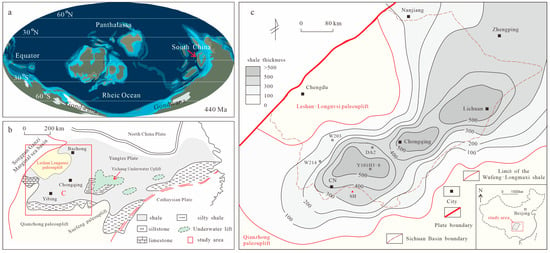
Figure 1.
The paleogeographic background of the study area. (a) Global Paleogeography of the Ordovician-Silurian transition; (b) Early Silurian paleogeographic map of the Yangtze epicontinental sea in southern Sichuan Basin; (c) Shale thickness in the Sichuan Basin of the Ordovician-Silurian transition.
During the Early to Middle Ordovician, a carbonate platform dominated the Yangtze platform’s sedimentary facies [14,15]. By the Late Ordovician, the platform was covered by a mixed carbonate-clastic epeiric sea. During the Ordovician-Silurian transition, global sea levels fluctuated significantly [16,17]. From the Early Silurian, the expansion of the Cathaysia Plate and the uplift of much of South China caused substantial changes in land and sea distribution (Figure 1b). Regional tectonism created ancient landmasses and subaqueous highs, transforming the Upper Yangtze region into a semi-closed sea [7,17]. This barrier resulted in prolonged anoxic and stagnant conditions in the Upper Yangtze region [17,18,19].
The Wufeng-Longmaxi interval is widespread across the Upper Yangtze region, with a thickness ranging from 0 to 550 m (Figure 1c). The Wufeng Formation is relatively thin, typically between 0 and 13 m [20]. It predominantly consists of black, graptolite-rich shale, except for a thin bioclastic limestone layer in the Guanyinqiao bed of the uppermost part (Figure 2). The Wufeng Formation overlies the Baota Formation and is overlain by the Longmaxi Formation. It contains graptolite biozones Dicellograptus complanatus (WF1), Dicellograptus complexus (WF2), Paraorthograptus pacificus (WF3), and Metabolograptus extraordinarius (WF4) from bottom to top [21,22].
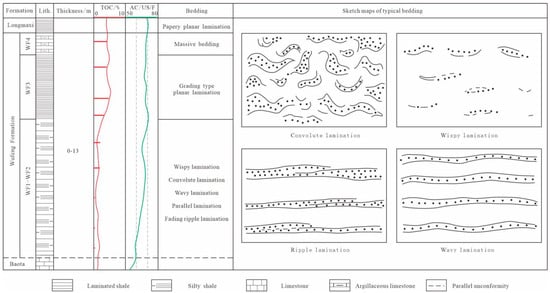
Figure 2.
Descriptive chart and bedding characteristics of Wufeng Formation in the southern Sichuan Basin, China.
3. Materials and Methods
3.1. Sample Preparation
The sedimentary facies of black shale were determined based on core descriptions, whole-size imaging of large thin sections, and field emission scanning electronic microscope (FE-SEM) observation of argon-ion polishing sections. Core descriptions are to determine color and sorting of shale. Whole-size imaging of large thin sections is to clarify stratification and lamination. FE-SEM observations are to identify mineral composition, texture, and fabric. The samples analyzed in this study were collected from the Wufeng shale in wells Y101H3-8 and DA2, located in the southern Sichuan Basin. Specifically, 24 samples from Well Y101H3-8 were used for whole-size imaging, and 7 samples were used for argon-ion polishing sections. From Well DA2, 10 samples were used for whole-size imaging, and 7 samples were used for argon-ion polishing sections. The size for large thin sections is commonly 5 cm × 7 cm × 30 μm, while the size for porosity and permeability analysis is 25 mm × 10 mm.
The preparation and imaging of the large thin sections were conducted by Beijing Tianhexin Co., Ltd. in Beijing, China. Porosity and permeability analysis were performed at the National Energy Shale Gas R&D (Experiment) Center, and FE-SEM analysis of argon-ion polishing sections was completed at the Experiment Center of the PetroChina Research Institute of Petroleum Exploration and Development.
3.2. Large Section Imaging and Microscopic Observation
The analysis of laminae, lamina sets, and beds primarily relied on descriptions of whole-size imaging of large thin sections. In this study, whole-size imaging was performed using the Leica 4500 P high-resolution digital microscopic platform from Wetzlar, Germany. A total of 3200 images were acquired from each large thin section and then seamlessly stitched together on a high-resolution performance workstation using Adobe Photoshop CS5 or later versions of the software. Lamination was subsequently described based on the composition, shape, continuity, and geometry of the laminae. Petrology analysis was conducted on standard thin sections using the Leica DFC450 photo system equipped with a Leica DMIP polarizing microscope from Wetzlar, Germany.
3.3. FE-SEM Analysis of Argon-Ion Polishing Section
To analyze the mineral composition of black shale, FE-SEM analysis was performed on argon-ion polished sections. The polished sections were prepared by cutting the shale samples into 10 mm × 10 mm × 5 mm slices, which were then subjected to argon-ion polishing. The polished sections were coated with a thin layer of carbon to enhance conductivity.
The FE-SEM analysis was conducted using a Hitachi FE-SEM (Tokyo, Japan) equipped with a secondary electron probe and X-ray energy dispersive spectrometer (EDS). The operating conditions were as follows: acceleration voltage of 15 kV, working distance of 10 mm, spot size of 300 nm, and maximum resolution of 9 nm per image. The EDS analysis had a resolution of 133 eV and a detection limit of 0.1 wt% for elements.
For calibration, certified reference materials with known compositions, including pure quartz, feldspar, and calcite, were used to ensure accurate elemental identification and quantification. The analysis focused on determining the mineral composition, content, morphology, sorting, roundness, and grading of grains to identify their origin.
4. Results
4.1. Fine-Grained Turbidite Deposits
The core of the shale is light gray to grayish black (Figure 3a). Low-amplitude, long-wavelength climbing ripples are common. Under the microscope, the shale exhibits normal grading with nine typical subdivisions (T0–T8) as described by Stow and Bowen (1980) [23].
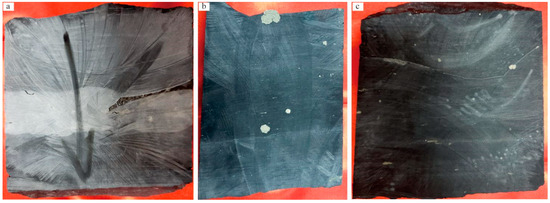
Figure 3.
Core photos showing different types of sedimentary characteristics of the Wufeng Formation in the southern Sichuan Basin. (a) Fine-grained turbidite deposits, well Y101H3-8, 3791.2 m; (b) Hemipelagic deposits, well Y101H3-8, 3695.4 m; (c) Shallow shoal deposits, well Y101H3-8, 3689.7 m.
Basal lenticular laminae (T0): The subdivision represents the lowermost part of a graded laminated unit, with a total thickness of 2.8–3.5 cm. It is primarily composed of silt laminae intercalated with small amounts of lenticular mud laminae. Within a single bed, the grain size gradually decreases from coarse silt to fine silt and even clay upwards (Figure 4a). The base is sharp and irregular, showing evidence of scouring, load casts, and mud injection structures. Internally, the subdivision contains abundant bioclasts along with a few escape structures. Upward, the sedimentary structures evolve from cross lamination (2 cm thick), to small-scale cross lamination (1.5 cm), to planar lamination (0.5 cm), and finally to fading ripples. The upper surface of the subdivision is either sharp or gradational, with a wavy or current-lineated appearance.

Figure 4.
Large slab photos showing characteristics of the Stow sequence of the fine-grained turbidite deposits. (a) Y101H3-8, 3791.2 m; (b) Y101H3-8, 3792.3 m; (c) Y101H3-8, 3790.4 m; (d) DA2, 3598.4 m; (e) DA2, 3597.6 m; (f) Y101H3-8, 3798.5 m.
Convolute laminae (T1): The subdivision is 0.9–1.9 cm thick, with a wavy, sharp contact with the underlying T0 (Figure 4b) and a gradational contact with the overlying T2. It is composed of silt laminae with abundant bioclasts and traces of mud laminae. Internally, convolute laminae are intercalated with chaotic dark strips. Compared to the T0 subdivision, this unit contains finer silt and higher clay mineral content.
Wavy-lenticular laminae (T2): The subdivision is 1.1–3.4 cm thick, with gradational contacts with both the underlying T1 and the overlying T3 (Figure 4b). It is primarily composed of silt laminae intercalated with thin mud laminae occurring in small troughs [24]. Upward, the silt content decreases, and the grain size becomes finer, forming a normal grading. Low-amplitude, long-wavelength climbing ripples are commonly observed, appearing discontinuous and lenticular in shape (Figure 4b).
Thin regular laminae (T3): The subdivision T3 is 0.5–1.0 cm thick, with gradational contact with both the underlying T2 and overlying T4. It consists of alternating graded silt laminae and mud laminae, with thicker and coarser silt laminae at the base and thicker mud laminae with fine silt laminae near the top. The bed surfaces are wavy, continuous, and sharp (Figure 4c). Small scouring structures are often observed at the base of the silt-clay graded beds, along with small wavy laminations and foresets.
Indistinct laminae (T4): The subdivision is commonly 1.2 cm thick and has gradational contacts with both the underlying T3 and overlying T5 (Figure 4d). It is mainly composed of mud laminae, with minor striped or lenticular silt laminae that are generally poorly continuous. This subdivision is characterized by graded planar lamination with unclear interfaces and slight variations of grain size, color, and mineral composition within a laminaset.
Wispy silt laminae (T5): The subdivision is commonly 0.5–1.7 cm thick (typically 1.2 cm) and has gradational contacts with both the underlying subdivision T4 and overlying subdivision T6 (Figure 4d,e). It is mainly composed of mud laminae with a small amount of silt laminae in wispy or chaotic forms.
Graded mud (T6): The subdivision is commonly 0.3–0.5 cm thick (occasionally up to 1.4 cm), and has gradational contacts with both the underlying subdivision T5 and overlying subdivision T7 (Figure 4d). Mud laminae dominate the subdivision. The silt laminae occur in lenticular shape with decreasing thickness and size upwards (Figure 4d). Generally, small low-amplitude long-wavelength ripple lamination evolve into lenticular lamination from bottom to top exhibiting faint normal grading in this subdivision.
Ungraded mud subdivision (T7): The subdivision is 0.2–0.6 cm thick and has a gradational contact with both the underlying subdivision T6 and overlying subdivision T8 (Figure 4d). It is composed solely of a mud lamina without any silt laminae. Wavy or intermittent dark strips commonly occur in this subdivision. The shale is generally homogeneous and lacks any graded lamination or bioturbation.
Microbioturbated mud (T8): The subdivision is 0.2–7 cm thick and has a gradational contact with the underlying subdivision T7 (Figure 4f). It consists of mud bed without any silt laminae. The mud lamina develops some wavy or intermittent dark strips. Generally, the shale is commonly homogeneous and intensely bioturbated with relatively light color. Clear individual trace fossils are also visible locally.
According to SEM analysis, the shale is composed of quartz (45.5–54.5%), clay minerals (29.0–38.9%), calcite (8.6–11.8%), plagioclase (4.3–6.1%), dolomite (3.6–6.0%), and trace amounts of pyrite (Table 1). The grain sizes are commonly 4.5–17.1 μm (average 8.8 μm) for quartz, 7.4–23.1 μm (average 15.3 μm) for clay minerals, and 9.5–17.6 μm (average 14.2 μm) for calcite. The grains are generally fine silt-sized and chaotically stacked (Figure 5a–d). The shale commonly exhibits intensive bioturbation with some distinct individual trace fossils (Figure 5b).

Table 1.
Mineralogical composition and characteristics of shale samples from the Wufeng Formation in southern Sichuan Basin, China.
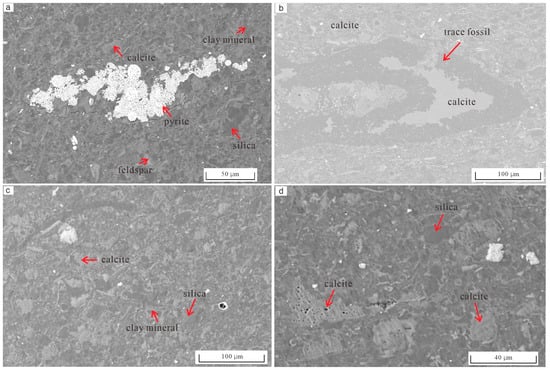
Figure 5.
Back-scattered electron SEM photos showing the characteristics of the fine-grained turbidite of the Wufeng Formation. (a) Y101H3-8, 3791.2 m; (b) Y101H3-8, 3792.3 m; (c) Y101H3-8, 3790.4 m; (d) DA2, 3598.4 m.
4.2. Hemipelagic Deposits
The core of hemipelagic deposits is commonly gray-black to black with faint alternation of light color and dark color (Figure 3b). Under polar microscope, the shale exhibits grading-type planar lamination [25,26]. The boundaries of laminasets are commonly indistinct or absent (Figure 6) and are parallel or wavy with each other. Individual laminaset is commonly 1.5–15 mm thick (average 4.5 mm). The shale becomes lighter and then darker gradually along with a coarsening and then fining trend within the single laminaset. The changes of color are closely related to their mineral compositions. For the intervals enriched in carbonate minerals and depleted in organic matter, the shale is relatively lighter. In comparison, for the intervals depleted in carbonate minerals and enriched in organic matters, the shale is relatively darker. Generally, the shale has a massive appearance without any bioturbation and disruption.
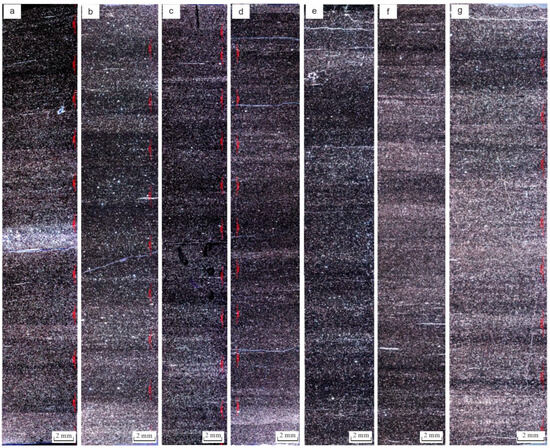
Figure 6.
(a–g) Large slab photos showing the characteristics of hemipelagic deposits in the WF3 biozone of the Wufeng Formation from CN outcrop of southern Sichuan Basin, China.
Hemipelagic deposits are commonly characterized by a mixture of terrigenous and biogenic materials. Under SEM, terrigenous materials include detrital quartz (12.3% on average), calcite (14.1% on average), and clay minerals (39.3% on average). Biogenic materials include autogenic quartz (24.2% on average) and dolomite (10.2% on average). The shale is commonly matrix-supported (Figure 7) with randomly oriented poorly sorted grain size. Detrital quartz commonly has irregular shape with grain size ranging from 8 mm to 12 mm (9.4 mm on average). Grains of calcite are commonly light gray and sub-rounded with harbor-like edges, diagnostic dissolution pores and grain size ranging from 2.1 mm to 11.5 mm (5.4 mm on average). Clay minerals commonly have curved stripe shape with grain size ranging from 3.1 μm to 8.1 μm (4.7 μm on average). Autogenic quartz is commonly self-shaped or semi-self-shaped with grain size <4 μm. Dolomite is commonly dark gray with angular shape and dissolution pores and grain size between 5.5 μm and 32.9 μm (14.5 μm on average). In black shale, a minor amount of framboidal pyrite is commonly present with grain size ranging from 4.1 μm to 6.1 μm (5.3 μm on average).
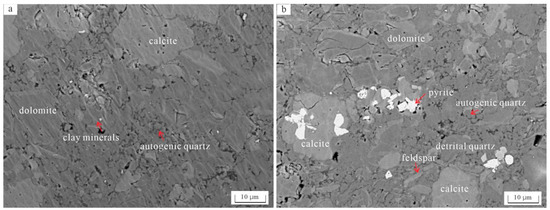
Figure 7.
SEM photos showing the characteristics of hemipelagic deposits in the Wufeng Formation, southern Sichuan Basin, China. (a) Y101H3-8, 3794.7 m; (b) Y101H3-8, 3795.6 m.
4.3. Shallow Shoal Deposits
The core of the shale is light gray to gray-black with some visible light-colored layers of bioclasts (Figure 3c). Under an optical microscope, the shale is mainly composed of limestone or calcareous mudstone. Intact bioclasts of various types, including brachiopods such as Triplesia sp., Fardenia sp., Oxoplecia sp., Dalmanella sp., Tetraphraerella sp., Plectothyrella sp.; trilobites such as Dalmantina nanchengensis Lu and Leonaspis sp.; planktonic organisms such as Climacograptus sp., Paraorthograptus sp., Diploraptus, Orthograptus sp., and Akidograptus sp., are common in this shale (Figure 8). Notably, the cold-water brachiopods, Hirnantia cf. magna, are particularly abundant in this shale.
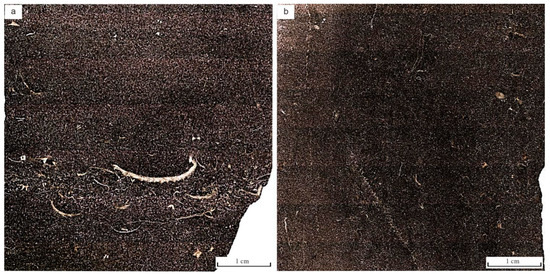
Figure 8.
Large slab photos showing the sedimentary characteristics of the shelf shoal deposits in the Wufeng Formation, southern Sichuan Basin, China. (a) Y101H3-8, 3785.2 m; (b) Y101H3-8, 3786.3 m.
The shale is a mixture of terrigenous and autochthonous (mainly of biogenic origin) materials. Under SEM, terrigenous minerals include clay minerals (30.5%) with minor plagioclase whereas autochthonous materials include dolomite (39.5%) and calcite (26.5%). The edges of dolomite are commonly with apparent calcitization (Figure 9). Clay minerals commonly have elongated or flake-like shapes with grain size ranging from 1.2 μm to 4.6 μm (2.4 μm on average). Dolomite is commonly dark gray angular shaped and has grain size ranging from 3.2 μm to 7.6 μm (5.8 μm on average). Calcite, with apparent dissolved pores, is commonly light gray angular shaped and has grain size between 1.8 μm and 7.3 μm (3.4 μm on average). Pyrite is commonly framboidal or crumby and has grain size ranging from 4.1 μm to 6.1 μm (5.3 μm on average).

Figure 9.
Scanning electron microscope photos showing sedimentary characteristics of shelf shoal deposits in southern Sichuan Basin, China. (a) Y101H3-8, 3785.2 m; (b) Y101H3-8, 3786.3 m.
4.4. Vertical Distribution of Various Sedimentary Facies
In the southern Sichuan Basin, the sedimentary facies occur in the order of fine-grained turbidite deposits, hemipelagic deposits, and shallow shoal deposits in the Wufeng Formation from bottom to top (Figure 10).
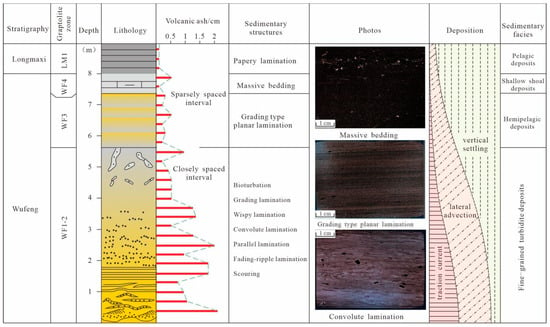
Figure 10.
Vertical distribution of various sedimentary facies of the Wufeng Formation in the southern Sichuan Basin, China.
The graptolite biozones WF1 and WF2 are dominated by fine-grained turbidite deposits. The deposits are mainly of terrestrial origin and are transported into the basin mainly because they are denser than the surrounding water. The graptolite biozone WF3 is dominated by hemipelagic deposits which are mixtures of terrestrial and autochthonous origin. The terrestrial materials were primarily transported to the basin by lateral advection. The graptolite biozone WF4 is characterized by shallow shelf sediments, indicative of relatively shallow water environments. The environment is favorable for the colonization of a large number of shallow water organisms and producing abundant bioclasts. The deposits of the shallow shoal are primarily composed of carbonate and clay minerals. Notably, calcite and dolomite are mostly angular shaped.
The development of various sedimentary facies is closely related to the thickness of volcanic ash (Figure 10). For the graptolite biozones WF1 and WF2, the thickness of the volcanic ash is between 0.5 cm to 2 cm with an average of 0.8 cm. For the graptolite biozone WF3, the thickness of the volcanic ash is between 0.2 cm to 0.6 cm with an average of 0.4 cm. For the graptolite biozone WF4, the thickness of the volcanic ash ranges from 0.1 cm to 0.5 cm with an average of 0.3 cm. Generally, the thickness of volcanic ash decreases gradually along with the changes of sedimentary facies from fine-grained turbidite deposits to hemipelagic deposits and to shallow shoal deposits from bottom to top for the Wufeng Formation.
5. Discussion
5.1. Genesis of Fine-Grained Turbidite Deposits
The black shale succession preserves a complete Stow sequence (T0–T8) diagnostic of fine-grained turbidite systems. T0–T1 units contain fine sand-silt with trough-hosted mud laminae, recording low-concentration turbidity currents with slow suspension settling. Associated wavy cross-lamination, planar lamination, and climbing ripples indicate high initial velocities (>25 cm/s) [27] and sustained traction [28], with sequential bedform development during flow deceleration [29]. Ripple formation requires specific grain sizes (50–180 μm) [30], flow durations (>minutes) [31], and sedimentation rates (<0.6 mm/s). Mud-rich flows suppress ripples through viscous damping of turbulence. T1 convolute lamination stems from post-depositional fluid injection through low-permeability layers, inducing liquefaction deformations [32,33].
T2–T3 feature rhythmic silt-mud laminae marking velocity decline. T2 climbing ripples with low amplitude/long wavelength suggest transitional flows (15–25 cm/s) with high silt loads [27], while T3 silt-clay grading reflects velocities <15 cm/s [32,34,35,36]. Boundary layer shear drives hydrodynamic sorting: turbulent flows maintain equivalent settling of clay flocs and silt, but shear-induced floc breakdown allows silt penetration through the viscous sublayer. Cyclical floc reformation creates repetitive silt-mud couplets [23,37].
T4–T6 mud-dominated laminae with minor silt record velocities <15 cm/s and enhanced viscosity [38]. Graded planar lamination implies ineffective boundary layer sorting [32], whereas wispy laminae denote ultra-low energy deposition. Pervasive convolute lamination reflects fine-grained, low-permeability sediment prone to deformation. T7 represents a nepheloid layer with residual current imprints [39,40], while T8 comprises structureless mud from post-flow pelagic settling [39,40]. Turbidity currents delivered nutrients/oxygen, promoting bioturbation that erased primary structures [41].
5.2. Genesis of Hemipelagic Deposits
Hemipelagites comprise silt-rich terrigenous-biogenic muds deposited through combined vertical settling and weak lateral advection [42]. The Wufeng Formation shale (Sichuan Basin) exhibits mixed terrigenous-biogenic origins, containing quartz (terrestrial/biogenic), calcite, and clays. Dominance of sub-16 μm grains with graded planar lamination indicates quiescent water column settling. Terrigenous components derive from river/turbidity plumes, where hypopycnal flows maintain suspended transport until hydrodynamic collapse enables deposition. Seasonal variations govern runoff intensity: enhanced spring-summer rainfall increases terrestrial quartz/carbonate flux and grain size, while reduced autumn-winter runoff yields finer sediments [43]. Notably, clay composition may incorporate volcanic inputs [44], with sub-4 μm grains predominantly reflecting biogenic/diagenetic processes [43,45].
5.3. Genesis of Shallow Shoal Deposits
Shallow shoal deposits are mainly a mixture of detrital components and production-derived components. The deposits are mainly originated from vertical settling with minor amount of slow lateral advection. The angular shaped grains of dolomite and calcite well-preserved clasts of bivalve and brachiopod suggest that these materials were mainly deposited in situ with short distance transportation. The high content of fine-grained clay minerals indicates a significant terrestrial origin. The mixed accumulation of clay minerals, calcite, and dolomite indicates a mixed origin [46]. In conclusion, the shale is formed under shallow shoal environment. In addition, clay minerals of the shale may be transported into basin by volcanic activity or bottom currents in suspension whereas calcite and dolomite may originate from calcareous organisms that died in situ or in quasi-situ conditions.
5.4. Evolution of Sedimentary Facies and Its Response to the Guangxi Movement
The tectonic movement may be the primary driver of the evolution of sedimentary facies for the Wufeng Formation. In the Late Ordovician, the southern Sichuan Basin was situated in the mid to low latitudes of the Gondwana Continent of the Southern Hemisphere. Influenced by the Guangxi Movement, the Yangtze and the Cathaysian Plates converged, and the Yangtze region transitioned from a passive continental margin basin to a foreland basin. The Guangxi Movement can be divided into three stages: (1) thrusting and flexural subsidence, (2) bending under tectonics and sedimentary loading, viscoelastic deflection, and equilibrium subsidence, and (3) late-stage slow subsidence, stress relaxation, erosion, rebound, and uplift [12,47]. The Wufeng period possibly corresponds to the first and second stage. The strong tectonic loading not only caused an angular unconformity between the Wufeng Formation and the underlying Baota Formation but also led to a shift from a clear-water carbonate sedimentary facies to a muddy-water fine-grained clastic sedimentary facies in the southern Sichuan Basin.
During the early Wufeng period, the Guangxi Movement was very active, leading to a rapid uplift of surrounding plates and strong volcanic eruptions. This movement produced sufficient sediment flux and volcanic ash, forming widespread fine-grained turbidite deposits intercalated with volcanic ash layers in the basin. During the middle Wufeng period, the basin evolved into a stage of equilibrium subsidence because of the waning Guangxi Movement. The reduced terrestrial supply and waning volcanic eruptions favored the formation of hemipelagic deposits. During the late Wufeng period, the basin evolved into a stage of slow subsidence because of the increasingly quiescent Guangxi Movement. As a result of continuous supplies of terrestrial flux and volcanic ash, the basin was dominated by shallow shoal deposits. During this period, the shallow water biological community flourished, forming abundant bioclasts and limestone.
Previous studies showed three origins of the volcanic ash: (1) the northward subduction of the Qinling ancient oceanic crust beneath the North China block on the north side of the Yangtze block, (2) extension and detachment along the northern margin of the Yangtze block, and (3) fragments of the Gondwana continent that subducted and collided from the southeast into the South China block. The volcanic ash produced by volcanic eruptions contributed to the enrichment of organic matter in shale, global sea level fall, reduced seawater temperatures, and upwelling of bottom water in the basin.
5.5. Shale Gas Significance
The sedimentary facies directly influence the quality of shale reservoirs. Laboratory data shows that the hemipelagic deposits have the highest porosity and TOC content, followed by shallow shoal deposits and fine-grained turbidite deposits (Figure 2, Table 2).

Table 2.
Reservoir characteristics of different sedimentary facies in the Wufeng Formation in the southern Sichuan Basin, China.
The porosity and TOC content of shale appear to be positively correlated with the content of autochthonous materials. Hemipelagic deposits have the highest content of autochthonous materials, resulting in the highest values of TOC content and porosity. In contrast, fine-grained turbidite deposits are primarily composed of allochthonous components, leading to lowest values of TOC content and porosity.
The sedimentary facies exert direct controls on shale reservoir quality, with TOC content serving as a critical proxy for both hydrocarbon potential and paleoenvironmental conditions. Laboratory analyses reveal distinct TOC variations across facies: Hemipelagic deposits exhibit the highest TOC values (2.91–4.10%), correlating with their dominance of biogenic quartz and minimal terrigenous dilution; Shallow shoal deposits show intermediate TOC (3.25%), reflecting mixed biogenic-terrigenous inputs; Fine-grained turbidite deposits display the lowest TOC (0.15–2.6%), attributed to high-energy depositional conditions that dilute organic matter with allochthonous siliciclastic sediments.
Elevated TOC in hemipelagic facies (>3%) aligns with prolonged anoxic bottom-water conditions, as organic matter preservation is enhanced under oxygen-depleted environments [1,2]. This interpretation is consistent with the laminated, unbioturbated nature of these deposits (Section 4.2). In contrast, lower TOC in turbidites (<2.6%) suggests intermittent dysoxic to oxic conditions during high-energy turbidity flows, which promoted organic matter degradation and dilution by coarse-grained sediments 33. The intermediate TOC in shallow shoals likely reflects seasonal hypoxia, where episodic stratification of the water column allowed partial organic preservation alongside carbonate production.
6. Conclusions
This integrated study of core, large-section imaging, and FE-SEM analyses reveals critical linkages between sedimentary facies evolution and the Guangxi Movement in the Wufeng Formation, with direct implications for shale reservoir characterization. Key findings include:
- (1)
- The complete Stow sequence (T0–T8) in fine-grained turbidites documents systematic flow deceleration from high-velocity (>25 cm/s) traction-dominated regimes to low-energy nepheloid settling. Hemipelagic deposits, dominated by sub-16 μm grains with graded planar lamination, reflect seasonal terrigenous influx modulated by hypopycnal plumes and volcanic inputs. Shallow shoal facies, enriched in angular biogenic carbonates, record in situ accumulation under quiescent conditions. These facies transitions are tightly coupled to boundary layer shear dynamics and hydrodynamic sorting mechanisms, as evidenced by cyclical silt-mud couplets and volcanic ash thickness variations.
- (2)
- The vertical progression from turbidite-dominated (WF1–WF2) to hemipelagic (WF3) and shallow shoal (WF4) facies correlates with three stages of the Guangxi Movement: Stage 1 (WF1–WF2): Intense tectonic compression and volcanic activity generated high sediment flux, driving turbidity current deposition; Stage 2 (WF3): Waning tectonism reduced terrestrial input, favoring hemipelagic sedimentation via mixed vertical settling and weak advection; (3) Stage 3 (WF4): Stabilized subsidence enabled carbonate production in shallow waters, with volcanic ash (<0.3 cm) acting as a nutrient source for biogenic productivity.
- (3)
- Hemipelagic deposits exhibit superior reservoir potential (porosity: 3.34–4.15%; TOC: 2.91–4.10%) due to biogenic quartz enrichment and minimal allochthonous dilution. In contrast, fine-grained turbidites show degraded properties (porosity: 1.58–3.81%; TOC: 0.15–2.6%) from dense terrigenous packing. This contrast highlights the critical role of depositional energy in organic matter preservation and pore network development.
Author Contributions
Conceptualization, Z.S.; methodology, Z.S.; software, T.Z.; validation, L.Q.; formal analysis, Z.S.; investigation, P.W.; resources, L.Q.; data curation, M.Z.; writing—original draft preparation, Z.S.; writing—review and editing, Z.S. and G.F.; visualization, T.Z.; supervision, G.F.; project administration, Q.Z.; funding acquisition, Q.Z. All authors have read and agreed to the published version of the manuscript.
Funding
This research was funded by the 14th Five-Year Plan of the Ministry of Science and Technology of PetroChina (Grant No. 2021DJ1901).
Institutional Review Board Statement
Not applicable.
Informed Consent Statement
Not applicable.
Data Availability Statement
The raw data supporting the conclusions of this article will be made available by the authors on request.
Conflicts of Interest
Author Guoyou Fu was employed by the company PetroChina. The remaining authors declare that the research was conducted in the absence of any commercial or financial relationships that could be construed as a potential conflict of interest.
References
- Allen, P.A. From landscapes into geological history. Nature 2008, 451, 274–276. [Google Scholar] [CrossRef] [PubMed]
- Wang, J.; Wu, C.; Zhou, T.; Zhu, W.; Li, X.; Zhang, T. Source and sink evolution of a Permian–Triassic rift–drift basin in the southern Central Asian Orogenic Belt: Perspectives on sedimentary geochemistry and heavy mineral analysis. J. Asian Earth Sci. 2019, 181, 103905. [Google Scholar] [CrossRef]
- Aplin, A.C.; Macquaker, J.H.S. Mudstone diversity: Origin and implications for source, seal, and reservoir properties in petroleum systems. AAPG Bull. 2011, 95, 2031–2059. [Google Scholar]
- Lazar, O.R.; Bohacs, K.M.; Macquaker, J.; Schieber, J.; Demko, T.M. Capturing Key Attributes of Fine-Grained Sedimentary Rocks in Outcrops, Cores, and Thin Sections: Nomenclature and Description Guidelines. J. Sediment. Res. 2015, 85, 230–246. [Google Scholar]
- Stow, D.A.V.; Howell, D.G.; Nelson, C.H. Sedimentary, tectonic, and sea-level controls on submarine fan and slope-apron turbidite systems. Geo-Mar. Lett. 1983, 3, 57–64. [Google Scholar]
- Brenchley, P.J.; Marshall, J.D.; Carden, G.; Robertson, D.; Long, D.; Meidla, T.; Hints, L.; Anderson, T.F. Bathymetric and isotopic evidence for a short-lived Late Ordovician glaciation in a greenhouse period. Geology 1994, 22, 295–298. [Google Scholar]
- Rong, J.; Harper, D.A.T.; Huang, B.; Li, R.; Zhang, X.; Chen, D. The latest Ordovician Hirnantian brachiopod faunas: New global insights. Earth-Sci. Rev. 2020, 208, 103280. [Google Scholar] [CrossRef]
- Melchin, M.J.; Mitchell, C.E.; Holmden, C.; Štorch, P. Environmental changes in the Late Ordovician–early Silurian: Review and new insights from black shales and nitrogen isotopes. Geol. Soc. Am. Bull. 2013, 125, 1635–1670. [Google Scholar]
- Wang, H.; Shi, Z.; Sun, S.; Zhao, Q.; Zhou, T.; Cheng, F.; Bai, W. Microfacies types and distribution of epicontinental shale: A case study of the Wufeng–Longmaxi shale in southern Sichuan Basin, China. Pet. Explor. Dev. 2023, 50, 57–71. [Google Scholar] [CrossRef]
- Yao, W.-H.; Li, Z.-X.; Li, W.-X.; Su, L.; Yang, J.-H. Detrital provenance evolution of the Ediacaran-Silurian Nanhua foreland basin, south China. Gondwana Res. 2015, 28, 1449–1465. [Google Scholar] [CrossRef]
- Yu, J.; O’Reilly, S.Y.; Wang, L.; Griffin, W.L.; Zhang, M.; Wang, R.; Jiang, S.; Shu, L. Where was South China in the Rodinia supercontinent?: Evidence from U–Pb geochronology and Hf isotopes of detrital zircons. Precambrian Res. 2008, 164, 1–15. [Google Scholar] [CrossRef]
- Wu, H. Reinterpretation of the Guangxian Orogeny. Chin. Sci. Bull. 2000, 45, 1244–1248. [Google Scholar] [CrossRef]
- Zhou, L.; Kang, Z.; Wang, Z.; Peng, Y.; Xiao, H. Sedimentary geochemical investigation for paleoenvironment of the Lower Cambrian Niutitang Formation shales in the Yangtze Platform. J. Pet. Sci. Eng. 2017, 159, 376–386. [Google Scholar]
- Munnecke, A.; Calner, M.; Harper, D.A.; Servais, T. Ordovician and Silurian sea–water chemistry, sea level, and climate: A synopsis. Palaeogeogr. Palaeoclimatol. Palaeoecol. 2010, 296, 389–413. [Google Scholar]
- Zhang, T.; Shen, Y.; Algeo, T.J. High-resolution carbon isotopic records from the Ordovician of South China: Links to climatic cooling and the Great Ordovician Biodiversification Event (GOBE). Palaeogeogr. Palaeoclimatol. Palaeoecol. 2010, 289, 102–112. [Google Scholar] [CrossRef]
- Haq, B.U.; Schutter, S.R. A Chronology of Paleozoic Sea-Level Changes. Science 2008, 322, 64–68. [Google Scholar] [CrossRef]
- Xu, C.; Jiayu, R.; Yue, L.; Boucot, A.J. Facies patterns and geography of the Yangtze region, South China, through the Ordovician and Silurian transition. Palaeogeogr. Palaeoclimatol. Palaeoecol. 2004, 204, 353–372. [Google Scholar] [CrossRef]
- Yan, D.; Chen, D.; Wang, Q.; Wang, J. Large-scale climatic fluctuations in the latest Ordovician on the Yangtze block, south China. Geology 2011, 38, 599–602. [Google Scholar]
- Zou, C.; Qiu, Z.; Poulton, S.W.; Dong, D.; Wang, H.; Chen, D.; Lu, B.; Shi, Z.; Tao, H. Ocean euxinia and climate change “double whammy” drove the Late Ordovician mass extinction. Geology 2018, 46, 535–538. [Google Scholar]
- Shi, Z.; Wang, H.; Sun, S.; Guo, C. Graptolite biozone calibrated stratigraphy and topography of the late Ordovician-early Silurian Wufeng-Lungmachi shale in Upper Yangtze area, South China. Arab. J. Geosci. 2021, 14, 213. [Google Scholar]
- Wang, H.; Shi, Z.; Sun, S.; Zhang, L. Characterization and genesis of deep shale reservoirs in the first Member of the Silurian Longmaxi Formation in southern Sichuan Basin and its periphery. Oil Gas Geol. 2021, 42, 66–75. [Google Scholar]
- Fan, J.; Melchin, M.J.; Chen, X.; Wang, Y.; Zhang, Y.; Chen, Q.; Chi, Z.; Chen, F. Biostratigraphy and geography of the Ordovician-Silurian Lungmachi black shales in South China. Science China. Earth Sci. 2011, 54, 1854–1863. [Google Scholar] [CrossRef]
- Stow, D.A.V.; Bowen, A.J. A physical model for the transport and sorting of fine-grained sediment by turbidity currents. Sedimentology 1980, 27, 31–46. [Google Scholar]
- Stow, D.A.V. Sedimentary Rocks in the Field: A Colour Guide; CSlRO Publishing: Clayton, Australia, 2010; pp. 1–318. [Google Scholar]
- Shi, Z.; Zhao, S.; Zhou, T.; Sun, S.; Yuan, Y.; Zhang, C.; Li, B.; Qi, L. Types and genesis of horizontal bedding of marine gas-bearing shale and its significance for shale gas: A case study of the Wufeng-Longmaxi shale in southern Sichuan Basin, China. Oil Gas Geol. 2023, 44, 1499–1514. [Google Scholar]
- Shi, Z.; Zhou, T.; Wang, H.; Sun, S. Depositional structures and their reservoir characteristics in the Wufeng–Longmaxi shale in southern Sichuan Basin, China. Energies 2022, 15, 1618. [Google Scholar] [CrossRef]
- Yawar, Z.; Schieber, J. On the origin of silt laminae in laminated shales. Sediment. Geol. 2017, 360, 22–34. [Google Scholar]
- Baas, J.H.; Best, J.L.; Peakall, J. Depositional processes, bedform development and hybrid bed formation in rapidly decelerated cohesive (mud-sand) sediment flows. Sedimentology 2011, 58, 1953–1987. [Google Scholar]
- Banerjee, I. Experimental study on the effect of deceleration on the vertical sequence of sedimentary structures in silty sediments. J. Sediment. Res. 1977, 47, 442–444. [Google Scholar]
- Jobe, Z.R.; Lowe, D.R.; Morris, W.R. Climbing-ripple successions in turbidite systems: Depositional environments, sedimentation rates and accumulation times. Sedimentology 2012, 59, 867–898. [Google Scholar]
- Sumner, E.J.; Amy, L.A.; Talling, P.J. Deposit structure and processes of sand deposition from a decelerating sediment suspension. J. Sediment. Res. 2008, 78, 529–547. [Google Scholar]
- Talling, P.J.; Masson, D.G.; Sumner, E.J.; Malgesini, G. Subaqueous sediment density flows: Depositional processes and deposit types. Sedimentology 2012, 59, 1937–2003. [Google Scholar] [CrossRef]
- Zhao, K.; Du, X.; Lu, Y.; Hao, F.; Liu, Z.; Jia, J. Is volcanic ash responsible for the enrichment of organic carbon in shales? Quantitative characterization of organic-rich shale at the Ordovician-Silurian transition. Bulletin 2021, 133, 837–848. [Google Scholar] [CrossRef]
- Lowe, D.R. Sediment gravity flows: II. Depositional models with special reference to the deposits of high-density turbidity currents. J. Sediment. Res. 1982, 52, 343–361. [Google Scholar]
- Boulesteix, K.; Poyatos-Moré, M.; Hodgson, D.M.; Flint, S.; Taylor, K.G. Fringe or background: Characterizing deep-water mudstones beyond the basin-floor fan sandstone pinchout. J. Sediment. Res. 2020, 90, 1678–1705. [Google Scholar] [CrossRef]
- Piper, D.J.W. Turbidite origin of some laminated mudstones. Geol. Mag. 1972, 109, 115–126. [Google Scholar] [CrossRef]
- Stow, D.A.; Bowen, A.J. Origin of lamination in deep sea, fine-grained sediments. Nature 1978, 274, 324–328. [Google Scholar] [CrossRef]
- Jeong, S.W.; Locat, J.; Leroueil, S.; Malet, J.P. Rheological properties of fine-grained sediment: The roles of texture and mineralogy. Can. Geotech. J. 2010, 47, 1085–1100. [Google Scholar] [CrossRef]
- Lash, G.G. Sedimentology and possible paleoceanographic significance of mudstone turbidites and associated deposits of the Pen Argyl Member, Martinsburg Formation (Upper Ordovician), eastern Pennsylvania. Sediment. Geol. 1987, 54, 113–135. [Google Scholar] [CrossRef]
- Lash, G.G. Sedimentology and evolution of the Martinsburg Formation (Upper Ordovician) fine-grained turbidite depositional system, central Appalachians. Sedimentology 1988, 35, 429–447. [Google Scholar] [CrossRef]
- Bromley, R.G. Trace Fossils: Biology, Taphonomy and Applications; Chapman & Hall: London, UK, 1996; Volume 129, pp. 193–194. [Google Scholar]
- Stow, D.; Smillie, Z. Distinguishing between deep-water sediment facies: Turbidites, contourites and hemipelagites. Geosciences 2020, 10, 68. [Google Scholar] [CrossRef]
- Zhao, J.; Jin, Z.; Jin, Z.; Wen, X.; Geng, Y. Origin of authigenic quartz in organic-rich shales of the Wufeng and Longmaxi Formations in the Sichuan Basin, South China: Implications for pore evolution. J. Nat. Gas Sci. Eng. 2017, 38, 21–38. [Google Scholar] [CrossRef]
- Schimmelmann, A.; Lange, C.B.; Schieber, J.; Francus, P.; Ojala, A.E.K.; Zolitschka, B. Varves in marine sediments: A review. Earth-Sci. Rev. 2016, 159, 215–246. [Google Scholar] [CrossRef]
- Su, W.; Huff, W.D.; Ettensohn, F.R.; Liu, X.; Zhang, J.; Li, Z. K-bentonite, black-shale and flysch successions at the Ordovician–Silurian transition, South China: Possible sedimentary responses to the accretion of Cathaysia to the Yangtze Block and its implications for the evolution of Gondwana. Gondwana Res. 2009, 15, 111–130. [Google Scholar] [CrossRef]
- Mount, J. Mixed siliciclastic and carbonate sediments: A proposed first-order textural and compositional classification. Sedimentology 2010, 32, 435–442. [Google Scholar]
- Wang, G.; Jin, Z.; Liu, G.; Liu, Q.; Liu, Z.; Wang, H.; Liang, X.; Jiang, T.; Wang, R. Geological implications of gamma ray (GR) anomalies in marine shales: A case study of the Ordovician-Silurian Wufeng-Longmaxi succession in the Sichuan Basin and its periphery, Southwest China. J. Asian Earth Sci. 2020, 199, 104359. [Google Scholar]
Disclaimer/Publisher’s Note: The statements, opinions and data contained in all publications are solely those of the individual author(s) and contributor(s) and not of MDPI and/or the editor(s). MDPI and/or the editor(s) disclaim responsibility for any injury to people or property resulting from any ideas, methods, instructions or products referred to in the content. |
© 2025 by the authors. Licensee MDPI, Basel, Switzerland. This article is an open access article distributed under the terms and conditions of the Creative Commons Attribution (CC BY) license (https://creativecommons.org/licenses/by/4.0/).